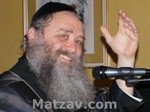 By Rav Shmuel Brazil
By Rav Shmuel Brazil
When Yaakov battles with the angel of Esav he asks him for his name upon which the malach returns with another question What is this that you inquire about my name? Rashi explains that this is an answer to Yaakov’s inquiry. The names of malachim change with the particular mission at hand. It appears to be that the malach was answering that he dosn’t have a fixed name and therefore he cannot answer. However, this is difficult to understand for why didn’t the malach give him the name for this specific mission? It is therefore that I would like to suggest another interpretation to the malach’s remarks.
The difference between a Yaakov and an Esav is the different functions of their eyes. Esav’s eyes are utilized to stimulate his body, to arouse sensual pleasure and material gratification. He does not look further than the contours and landscape of nature. He is called Edom red because the lens that he possessed only saw the color of red of the lentil soup. His eyes could not penetrate past the surface for fear it might deliver to him as our Chazal state a too demanding message that he too should do teshuvah because death is inescapable. This is the essence of Esav and his culture, flashing lights, media choreography, blasting and pumping chaotic music, and tantalizing visual sights. In contrast is the eye of Yaakov the Yid, an eye which is constantly focused on the inner core and existence of all creation which is Hashem. It is a physical eye tuned to the ain haseichel the vision of the intellect likened to the Sanhedrin which is called ainay haaidah who are the eyes of the congregation of Yisrael. It is the eye that seeks meaning in every object and every event that falls within his four cubits from moment to moment, day to day, week to week ,month to month ,and year to year.
Even in spiritual matters we can have either the lens of Yaakov or Esav. The eye of Esav is satisfied to merely surf the halacha or minhag as for example in not to eat on Rosh Hashanah anything made of egoz – walnut for it is the gematriah of chait and we do not want to stir up any hinting to sin on this serious Day of Judgment. However, the eye of Yaakov realizes that the word chait is also gematria chait and thereby focuses on the more challenging inner demand of staying far away from any sort of avairah on Rosh Hashanah.
Esav and his angel align themselves with the identical perspective and ideology of today’s slick advertisements and slogans whose basis is don’t think and don’t delve “Just Do It” (Nike) “Obey Your Thirst”, ‘Do What Feels Good”. For this culture truly recognizes that if G-d forbid one thinks for even a moment they will come to realize that he is being duped in a big way. So they first get you “shock vaccumed” into their technological ad by hijacking your intellect by pushing all the impulsive buttons of your body. When Yaakov asks for the malach’s name he answers all “five” of them none other than Mr. WHY ASK FOR MY NAME. His name symbolizes that his deceit and seduction to sin is that he does not want one to ask or question. Just obey and listen and by this non inquiry this constant liar promises that immediately afterwards you will be happy.
This concept is reaffirmed by the fact that the malach attacks Yaakov at the crossing of Yabok. Here, the hypocritical malach of Esav, while he professes to everyone else not to delve into names, looks very deeply and strategically into the name providing it fits his own agenda. His whole purpose is to blind Yaakov of the intellectual eye and spiritual perspective on this world. He realizes that Yaakov’s name is spelled with the letter ayin in it. It is based on the passuk (Devarim 33,28) vayishkon Yisrael betach badad ain Yaakov. Am Yisrael dwells with security as long as they have separated themselves apart from the goyim and constantly use the ain – the eye of Yaakov. For when Klal Yisrael are focused to see the world through spiritual lenses, with it comes the merit of the protective hashgacha of Hashem. It is this ayin from the name Yaakov that the malach of Esav sought to rob Yisrael from. So what other place would be more prone and susceptible to accomplish such an incredible feat than “Yabok”. For if one looks closely at the letters of Yabok, he will immediately discover that they are the identical letters of the name of Yaakov only minus the letter ayin. Esav’s malach clearly understood that if Yaakov had to be defeated then this was the place which matched up to such a victory.
The Shelah Hakadosh writes that the effect of this battle of Yaakov with the angel of Esav actualized during the second Beis Hamikdash in the times of the Greek culture. The Greeks possessed the physical eye that leaves darkness in its path. It is an “eye” which is directed and takes its orders from the “I”, which adorns everything that is earthly and pleasurable. This was in contrast to the menorah which represents the eye of Yaakov, the light of Torah and an inner penetrative perception of the universe and the creator behind it. It is not the “I” that leads this eye but the “U” that refers to Hashem and the benefit of one’s fellow man.
Even thought Yaakov was injured in the kaf of his thigh, an injury which rippled into actualization during the Greek galus, the Chasmonaim remedied this injury with the miracle of the flask of oil the pach shemen, by transforming the letters of kaf to pach. The light of Torah for which the Chashmanaim sacrificed their lives, dispelled the darkness of Yavon, the Greeks whose eyes were used solely for hedonistic fulfillment. Their objective was similar to the Sar of Esav to lower the intellectual eye of the Yid into the lower worlds inn order to utilize Man’s intellect only to further more intense new and instantaneous pleasures. By analyzing the letters of Yavon we will find that it is spelled with a yud then a lowering of the yud to a vov and then even a further lowering of the vov into a nun. For the sefarim explain that the letter yud symbolizes the intellect and Yavon used their intellect for the purpose of earthly pleasures and ecstasies.
Chanukah is the time when the mitzvah is not only to light the menorah but also to see the lights. It is this seeing that separates us from our host cultures. The Jewish nation sees with eyes of the spirit that bring a beacon of light to the dark world brought about by man’s I of selfishness and earthly cravings. The She’itlos of Rav Achaee Gaon says that one should light the menorah towards the left door post with the mezuzah on the right and he should be in the middle wearing his tallis as he lights. Why is it significant to wear a tallis while lighting the menorah? Although the full answer is beyond the scope of this dvar Torah, we will explain in short as follows. The full mitzvah of tzitzis which is derived from the word tzitz which means to see, is with the strings of blue which reminds one of the sea, the heavens and the kisay hakavod. This defines the eyes and seeing of the Yid in that he focuses on the Throne of Glory which states that every earthly creation is a vehicle for the glory of Hashem. The victory of the Chanukah reaffirmed this constitution in contrast to the Greek philosophy of life. It is therefore befitting to adorn oneself with this tzitzis this spiritual eye while lighting the menorah that symbolizes Torah.
We can now understand an incredible parallel between the tzitzis we wear every day and the dreidel of Chanukah. The tziztis that we wear under our shirts is a circle within a square, a circle for our heads and a square for the four corners of the tziztis upon where they are placed. Every earthly creation is basically round since it is composed of atoms that run in circles at incredible speeds. Even the earth and planets have a circular structure. The purpose of the tzitzis is to remind the Yid that within the circles of this world one must see the square which symbolizes the supernatural as the four flags of Bnei Yisrael which emulated the four flags of the malachim. That is why Yavan is gematriah galgal which means circle. Their eye which is called also galgal haayin (iris pupil which are round) sees only circles of olam hazeh and never the inner existence of all creation. However the tachlis which is represented by the techailis of the tzitzis is to see the squares that surround the circles. Chanuikah was the yom tov when this realization came to fruition. That is why we spin the dreidel which parallels the tzitzis. The dreidel is a square with four sides like the degalim which spins around the circle made by the pivot of the dreidle.
The pupil of the eye is the opening in the iris that lets the light enter the retina. It is no coincidence why the pupil of the eyes share the same meaning as pupil in the sense of student. For everyone’s eyes are pupils of different lights. Esav’s eyes are pupils of the physical world to let the “I” and body see and derive pleasure from earthliness as much as possible. The Yaakov eye is a pupil of the inner light, to let it penetrate the body, elevate it, sanctify it, and let it serve as a vehicle for Hashem’s glory and honor. Chanukah is he festival of lights. One must ask himself to which pupil does his eyes learn from.
{Matzav.com Newscenter}









